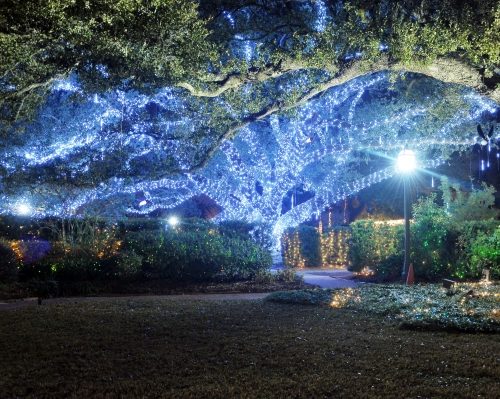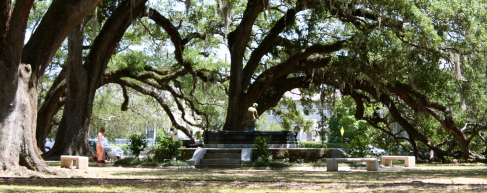Editor’s Note: 85% of the US population owns a smartphone(statista). This adds to the constant busyness of lives and makes it hard to unplug; it can also lead to unneeded stress. According to a 2019 study published in Scientific Reports, spending at least 120 minutes in nature a week is associated with good health and decreased stress (White et al). In other words, sometimes we are in need of a stroll through the park, so that’s what we’re giving you. The following is a collection of articles about different parks in New Orleans. The collection features historical articles, talking about the history of different parks; informative articles, featuring different events that can be attended at parks; and creative writing that draws inspiration from the park’s beauty. Our goal through curating this selection was to give anyone the ability to take a virtual stroll through the park. We hope this collection provides a much needed disconnect from the world, and inspires you creatively. This piece on the history of City Park was originally published on Nov 30, 2017.

Celebration of the Oaks (photo credit: neworleanscitypark.com)
Celebration in the Oaks draws 165,000 visitors to City Park each holiday season. This year, it celebrates its 31st anniversary. Beginning the weekend after Thanksgiving and continuing to New Year’s Day, visitors can walk through half a million lights and view installations such as The Cajun Night Before Christmas, Prancing Peacocks, a karaoke Santa and a Dripping Snow Tree that alone has 42,000 LED bulbs.
But Celebration in the Oaks isn’t City Park’s first rodeo. For the past 160 years, this 1300-acre space – half again as large as New York’s Central Park – has seen its share of notable happenings. Back then, the space played host to such New Orleans-centric events as daily duels beneath its stately oak trees or, later, nightly dancing under the stars at its neo-classical Peristyle. Now, you see more 21st-century affairs, like yoga and pilates classes in the Sculpture Garden, or the loud and proud Voodoo Music Experience each fall. And an actual rodeo, too, this one of the fishing variety. Some things at City Park bridge the then-and-now gap, like the authentic Venetian gondola that plies the waters of Big Lake and fulfills Robert Dula’s childhood dream of being a real gondolier.
Two 25-foot marble pylons called the Monteleone Gates lead into City Park from Esplanade Avenue. They’re named after former City Park commissioner Antonio Monteleone, who not only ran the famous French Quarter hotel that bore his name, but also owned a local shoe factory that, in 1888, was turning out 500 pairs of shoes a week. A more romantic link between Monteleone and the park is the carousel: the one at his hotel is a rotating bar, while the flying horses at City Park are the real thing — and one of just 100 antique carousels left across the U.S.

The oaks of City Park (photo credit: neworleanscitypark.com)
To the left of the Monteleone gates lies an open grassy area where the Allard Plantation once stood. Louis Allard has been described as “cultured but impractical.” He was a man of letters who was better at poetry and politics than raising sheep or sugarcane. He spent his declining days writing verses beneath his favorite tree, one of the famous Dueling Oaks, and asked to be buried there. So in 1847 he was laid to rest under the branches of the giant tree. More than a century later, however, when the park was being developed and the grave was opened, there was no coffin to be found. To this day, no one knows what happened to Allard’s body.
The Dueling Oaks were just that – meeting places where disputes were resolved by sword or pistol. Before the Civil War, duels were fought almost daily under the oaks. Now, only one of the two giant trees remains. One was destroyed by a hurricane in the 1940s. The other is 70 feet high and thought to be 300 years old. That’s nothing compared to some of its neighbors. City Park has one of the largest collections of mature oaks in the world, with the oldest rumored to be 800 years of age.
New Orleans philanthropist John McDonogh bought Allard’s plantation at a sheriff’s sale in 1947, and left it to the city in his will. It was designated a city park in 1859, but its history was shaped by two later events: the Great Depression and Hurricane Katrina. The first led to the Works Progress Administration, which poured $12 million and 20,000 workers into a redo of the park. Almost a century later, Katrina left 95 percent of the park sitting in floodwaters, inflicting $43 million in damage. The public responded with an overwhelming outpouring of support that has funded not only repair, but also improvements. There’s a new golf course, a mini-golf course, 26 tennis courts, a new fishing pier, jogging and nature trails and the 4-acre New Orleans City Bark for dogs.
In the past, people gathered at the park for their evening entertainment. Turn-of-the-century New Orleanians danced at the Peristyle from 6 to 11:30 each evening. Or they headed over to Popp’s Bandstand to watch pictures via the Vitascope, one of the first types of motion-picture projectors.
Now, people still gather at the park for their evening entertainment. They still watch outdoor movies, these days of the digital variety, and still listen to live music under the stars, at the Thursday Night twilight concerts in the Botanical Garden. And, of course, they take in Celebration in the Oaks, with its one-of-a-kind holiday offerings, from Jingle Bells and Beer for the over-21 crowd to Mr. Bingle’s 70th birthday party for the younger set.
It’s a far cry from penning poetry under the Dueling Oaks. But Allard, I think, would approve.
For more information about events at City Park, including Celebration in the Oaks, go to neworleanscitypark.com. Our thanks go to the University of New Orleans history Department and New Orleans Historical for research used in this story. Content and research comes from the New Orleans Historical website and is reposted here with their permission.
You
For WWNO and NolaVie, I’m Renee Peck.
 NOLAbeings
Multimedia artist Claire Bangser created NOLAbeings as a portrait-based story project that marries...
NOLAbeings
Multimedia artist Claire Bangser created NOLAbeings as a portrait-based story project that marries...
 Data corner: Adobe Suite (create a PDF, social media graphic, presentation, edit a photo and video
Data corner is where you go to work with analytics and top tech skills. It takes on everything from PERL and SQL to Canva and Sprout Social.
Data corner: Adobe Suite (create a PDF, social media graphic, presentation, edit a photo and video
Data corner is where you go to work with analytics and top tech skills. It takes on everything from PERL and SQL to Canva and Sprout Social.
